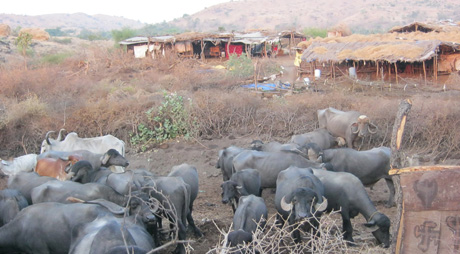Contesting the Commons: Travelling Norms of Nature Conservation
International norms of biodiversity conservation consider the establishment of uninhabited ‘protected areas’ as an effective way to protect nature. This essay examines the ideology and practices of new regimes of environmental governance in Gir forest (western India) by delineating (post)colonial continuities in displacement, dispossession and the curtailment of the rights of forest-dwelling communities.
Shalini Randeria
Imperialism brought about profound transformations in the conceptualizations of nature and society as well as in the legal and institutional regimes for their control in European metropolitan centers and colonies alike. Pervasive changes in landscapes, ecologies, and ideas about nature – whether as wilderness in need of conservation or as a resource to be exploited for economic gain – are among the most enduring legacies of British colonial rule all over the world. The current policies and practices of environmental governance in India have inherited these contradictory colonial ideologies of nature.
Ironically, the environmental interventions of the post-colonial state have extended the scope of colonial categories, discourses and mechanisms of surveillance and the control of nature and local populations. In the name of development as well as management of biodiversity, ever more territories and communities have come under the control of the post-colonial state. International organizations like the World Bank and international NGOs like the World Wide Fund for Nature (WWF) have undergirded this process.
The new globalized forms of ecological governmentality include elements from several Western strands of conservation ideology. Among these is the now hegemonic idea of biodiversity conservation, enshrined in the international Convention for Biological Diversity, which in turn is based on the U.S. model of National Parks that identifies uninhabited wilderness reserves as ‘protected areas.’ This term encompasses various levels of protection ranging from highly restrictive national parks to wildlife sanctuaries, where communities inhabiting the area have greater rights.
A clash of models of conservation
My argument on the effects of (post-)colonial environmental regimes is based on ethnographic material generated in the Gir forest, which was home to a World Bank funded biodiversity conservation program in the western Indian state of Gujarat. Gir is the last intact habitat of an estimated 304 Asiatic lions according to a 1995 census. The Government of Gujarat declared parts of the forest a wildlife sanctuary in 1965. In 1975, a part of the area was turned into a national park. Within the territory classified as ‘protected area,’ there are 54 traditional livestock-owning pastoral communities (known as Maldharis, i.e. owners of cattle). Their population totals 2,540. [1] About 14,200 heads of cattle belonging to them graze in the sanctuary but are not permitted to cross into the area now demarcated as national park.

Pastoralists emphasize their own positive contribution to conservation including their intimate knowledge of and care for their surroundings, as well as the symbiotic relationship between their buffaloes and the lions that prey on the herds of cattle. By contrast, state forest officials, international organizations, and environmentalist NGOs all advocate conservation norms derived from a Euro-American ideology of ‘protected areas.’ Among its assumptions is an antagonism between the rights of nature and those of local inhabitants. The expansion of protected areas thus leads to the conversion of inhabited forests into uninhabited national parks, which turns forest-dwellers with a variety of usufruct rights to commons into encroachers, illegal residents and law-breakers through a redrawing of cartographic boundaries.
Dilemmas of displacement
Pastoralist families that were forcibly resettled outside the boundaries of the protected area thus lost their livelihood and customary access to the commons. Ironically, not even the lions benefitted from the eviction. For as the pastoralists point out, the Asiatic lions’ survival in the Gir forest depends on a delicate ecological balance maintained by the presence of the pastoral communities’ buffaloes. With the displacement of the cattle and their owners, the lions were forced to move further out into the sanctuary area and beyond in search of prey. Some lions had to be shot when they began to prey on cattle in the villages around the Gir forest, even turning into man-eaters on occasion.

Community-based NGOs have tried mobilizing public opinion, organizing protests, and filing court cases in order to protect the rights of the pastoralists to live and move freely in the forest, collect forest products, graze cattle, and access fodder and water. In the Gir forest they were pitted against the Indian chapter of World Wide Fund for Nature (WWF-International) and the state government of Gujarat, who argued that the traditional grazing practices of the pastoralists endangered both the fragile local ecological system and the lions. Accordingly, in the name of the common good of biodiversity protection, the joint action of these groups restricted the pastoralists’ rights.
In terms of the overriding commitments accepted by the Government of India, World Bank policies safeguarding those affected by a project from involuntary displacement prevail over national laws for the limited duration of the project and within the project areas. Unable to protect the rights of local forest-dwelling communities under the national law that requires the relocation of any person living within areas demarcated as national parks, human rights NGOs together with peoples’ organizations, therefore, strategically invoked the World Bank’s norms against involuntary displacement. They were thus able to prevent further forcible evictions that would have violated the World Bank’s conditionalities for the credit given for the biodiversity project.
Competing cosmopolitan visions
The ‘parks vs. people’ conflict in the Gir forest alerts us to a clash of cosmopolitanisms, reflecting the contrast between two visions of the relationship of local communities to nature. These contending visions entail very different designs of (world) citizenship. I have called the bearers of these visions “footloose experts” and “rooted cosmopolitans.”[2] The one, based on values of biodiversity conservation, is a totalizing and technocratic vision in which the local population is seen as a major threat to nature. Seeing themselves as representatives of global stakeholders in nature, transnationally linked experts working for international organizations and (inter)national NGOs share this vision.
Grassroots activists articulating an alternate vision question this biocentric view of the relationship between society and nature. They insist that environmental protection and natural resource use are not technical but political issues. Arguing against a narrow environmentalist agenda that pits peoples’ rights to access commons against conservationist goals, they seek to protect the claims of local communities to natural resources. They link ecological problems to questions of political economy, social justice, and citizenship rights. Such a cosmopolitan perspective gives primacy to the survival needs and cultural priorities of resource-dependent communities over the rights of nature.
Rooted cosmopolitans contest the definition of common good advanced by (inter)national experts and the state. Bound by neither national loyalties nor a statist vision, these activists may also transcend the nation-state in search of ideas and alliances. They freely borrow and mix norms of heterogeneous origins in order to defend the rights of local populations under threat from the new regime of ecological governmentality. Their advocacy of the traditional rights of local communities is framed in terms of universalist discourses of human rights, the rights of indigenous communities, and the value of localized knowledge of nature for environmental sustainability, all of which constitute a global counter-hegemonic discourse.
Glocalization of law
With the imposition of English common law throughout the British Empire, the principle of ‘eminent domain’ was exported to the colonies. It refers to the power of the state to appropriate property without the consent of the owner and convert it for public use by virtue of its sovereignty over all lands within its jurisdiction. The post-colonial Indian state has retained this Anglo-Saxon legal principle. This remnant of British law not only contravenes the customary rights of local communities to commons but also is unable to accommodate the survival needs of resource-dependent communities. Therefore, activists advocate its replacement by the American doctrine of the state as ‘public trustee,’ challenging the absolute nature of the ‘eminent domain’ concept. This principle imposes obligations and constraints on the use and sale of natural resources by the state, since it views the state as trustee rather than as owner of natural resources within its territory.
Instead of drawing on pre-colonial Indian traditions for allegedly authentic alternatives to modern western legal concepts and norms, these activists have chosen to set aside a judicial principle of colonial provenance through advocating its replacement by a more suitable, contemporary American one. The political ideas and practices of these community-based cosmopolitans are forged in a context and articulated in a vocabulary that is inflected with the vernacular but which is not entirely local. Here we have not only an interesting example of a creative process of ‘glocalization’ of legal norms by non-state actors[3], but also an unusual trajectory of travelling norms resulting in the Americanization of Indian law by grassroots activists aiming to counter the global designs of biodiversity conservation.
1 World Bank (1996), Staff Appraisal Report: India, Ecodevelopment Project, report no. 14914-IN, August 3, 1996.
2 See Shalini Randeria (2007), “Global Designs and Local Life-worlds: Colonial Legacies of Conservation, Disenfranchisement and Environmental Governance in Postcolonial India,” in: Interventions: International Journal of Postcolonial Studies, 9(1), pp. 12–30.
3 See Shalini Randeria (2007), “The State of Globalization: Legal Plurality, Overlapping Sovereignties and Ambiguous Alliances between Civil Society and the Cunning State in India,” in: Theory, Culture and Society, 24(1), pp. 1–33.
Shalini Randeria
Shalini Randeria is a founding member of the URPP Asia and Europe and a former professor of social and cultural anthropology at the University of Zurich. Since September 2012 she chairs the newly formed Anthropology and Sociology Department at the Graduate Institute of International and Development Studies, Geneva. Fortunately, she continues to be an associated member of the URPP Asia and Europe.
(Asia & Europe Bulletin, 2/2013, pp. 4–6)
